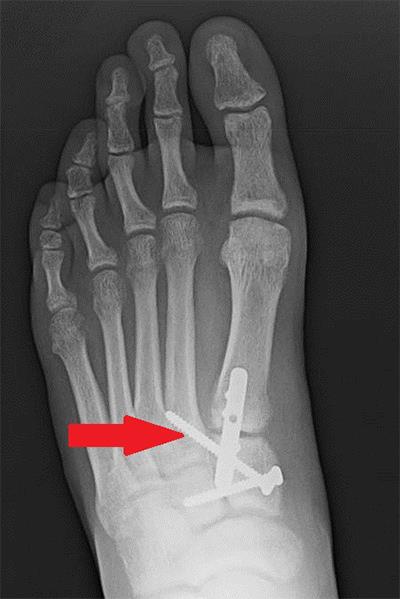Naviculocuneiform Joint
The naviculocuneiform (NC) joint is located in the middle of the foot. It consists of four bones: the tarsal navicular and the medial, middle, and lateral cuneiforms.
The main reason to perform NC joint fusion is to relieve pain related to arthritis. Arthritic joints in the midfoot typically occur after trauma to that region or as part of a collapsing foot arch. When a joint is arthritic, the cartilage has worn away and the bony surfaces rub together, which causes pain. The goal of the fusion is to get the bones to heal together so the pain goes away. Sometimes patients whose arches have collapsed will have a deformity that requires NC fusion to correct it.
Diagnosis
Patients will notice pain on top of the foot with tight shoes or weightbearing activities. This pain can prevent them from being able to walk for any length of time. The pain usually is worst after the patient gets up from resting or sitting. It can improve slightly with walking but then gets worse with continued walking.
Surgery should be avoided if you have any signs or symptoms of a bone or skin infection to the same foot or ankle as the planned procedure. An infection can prevent the bones from healing together and lead to more surgery in the future.
Smoking increases the risk of blood clots, wound healing problems, and the possibility the fusion won’t heal. You should completely stop nicotine use at least one month before surgery and abstain until the fusion has healed. Inability or unwillingness to follow the treatment plan may mean surgery is not for you.
Treatment
Depending on the general health of the patient and what other procedures are planned to take place with the NC fusion, the procedure often is done on an outpatient basis. Patients are put to sleep with general anesthesia. A nerve block may also be offered. This will make the operative foot and ankle numb and help with pain control after surgery.
Generally, a single incision along the inside of the foot is used to gain access to the joint. After the joint is identified, the cartilage that remains on the bones is removed and the bones are then positioned back in their correct location and held in place with screws or a combination of plates and screws. The wounds are then closed with stitches or staples and the patient is placed into a well-padded splint. Patients stay off the operative foot for six to eight weeks.
Specific Techniques
During surgery, the lining of the joint is opened and the joint surfaces are evaluated. More often than not, the top of the joint surface has been worn away while the bottom of the joint still has cartilage in place. After all of the cartilage has been removed, holes are placed in the underlying bone to allow bleeding at the joint, which helps the bones heal together. Bone graft also may be used to help the bones heal together.
Recovery
Normally, patients are placed into well-padded splints while in the operating room. Patients are asked to keep their dressings clean and dry at all times and to not remove the dressing unless instructed to do so by their foot and ankle orthopedic surgeon.
The first two weeks after surgery usually are spent with the foot elevated to help decrease swelling. At around two weeks the stitches/staples are removed and X-rays are taken. The patient typically will be placed into a cast or boot and remain non-weightbearing for another 4-6 weeks.
Six to eight weeks after surgery, the patient will come out of the cast or boot and X-rays will be taken to assess healing. If all looks good the patient can begin weightbearing slowly. Physical therapy may be recommended to improve strength and range of motion of the foot and ankle. Some patients may have residual swelling and periodic discomfort in the year following surgery, but the majority of patients are back to normal activities in four to six months.
Risks and Complications
All surgeries come with possible complications, including the risks associated with anesthesia, infection, damage to nerves and blood vessels, and bleeding or blood clots.
Complications from this procedure can include delayed wound healing, infection and delayed bone healing or no bone healing at all. All of these complications generally require further surgery to try and correct the problems. These complications are rare but happen more frequently in diabetic patients and those who smoke.
FAQs
After the bones grow together, will I still be able to walk or run?
In a normal foot, there is limited motion at these joints, so removing painful motion generally will not have any negative effect on your ability to walk or run. A successful naviculocuneiform fusion should allow you to walk or run pain-free once you have recovered fully from the surgery.
Why do I need to be non-weightbearing for so long?
Typically, in a healthy non-smoking patient without diabetes, bones take six to eight weeks to heal. Patients are asked to remain non-weightbearing for that period to prevent motion between the bones that are trying to heal together. If there is too much motion between the bones, it can take longer for them to heal or they may not heal at all.
What if my bones do not heal together?
The term for this is nonunion. It is more common in patients who are diabetic or who smoke. Additionally, patients who put weight on the foot prior to the bones healing can cause this. If this happens the patient will continue to have pain just like before surgery. A nonunion requires another surgery. More or bigger plates and screws can be tried the second time, and usually some form of bone graft is used to try and help the bones heal.


